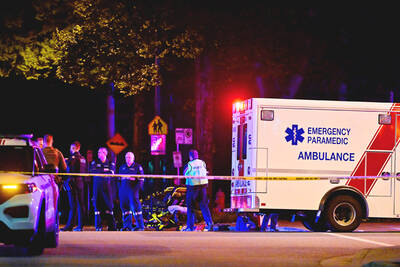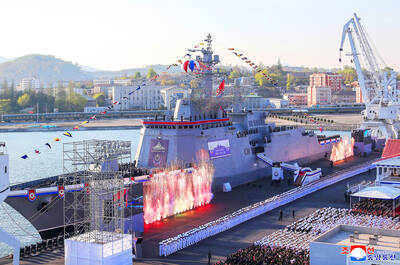One of the cleaning ladies in the building won’t enter the room where the vials are stored because she can feel the restless souls inside them.
But for 33-year-old biologist Amela Jamakovic, the 11 vials, each containing a few grains of bone powder that look like sand, are her daily assignment.
She’s part of a team of six at the laboratory of the International Commission for Missing Persons in Sarajevo that’s on a daunting mission: analyzing DNA from bones found in mass graves from atrocities or natural disasters around the world and matching it to lost lives.
The researchers try to restore identity to nameless remains by comparing the DNA to genetic material collected from living relatives. The detective work has been carried out on remains of victims from the 1990s Balkan wars, the Pinochet regime in Chile, Typhoon Frank in the Philippines, Hurricane Katrina in Louisiana and Asia’s December 2004 tsunami.
Those efforts have been dwarfed by the commission’s latest mission: helping Iraqis find and identify the victims of former Iraqi president Saddam Hussein.
Officials in Baghdad estimate that 350,000 human remains are hidden in mass graves throughout the country. Human rights groups say it could be close to 1 million.
When Jamakovic adds liquid to the grains of bone to form a solution ready for analysis, she likes to think she is performing a kind of alchemy that will conjure up an identity from dust and lead to peace and closure for a bereaved family.
For the past two years, the team has been bringing Iraqi forensic archeologists, anthropologists, nurses and other experts to Bosnia for training on collecting blood samples, excavating mass graves and setting up labs in Iraq.
Some of the dead were killed in the Iran-Iraq War in the 1980s.
Others were Kurds, killed because of their ethnicity, or Shiites, massacred because of their religion, or Sunnis, eliminated because of their political views.
If the estimates of human rights groups prove accurate, “they represent a crime against humanity surpassed only by the Rwandan genocide of 1994, Pol Pot’s Cambodian killing fields in the 1970s and the Nazi Holocaust of World War II,” a 2004 report from the US Agency for International Development said.
Building on the Iraq numbers are the unknown number of mass graves filled by victims of post-Saddam revenge killings as Sunnis, Shiites and rival political factions used the turmoil to settle scores.
It could take decades to find names for the bones from Iraq, but it will contribute to peace, said Adam Boys, the deputy head of the commission, who sees his work as “not for the dead, but for the living.”
In Iraq, there are likely to be millions enduring that fate.
The current situation “has catastrophic effects on Iraqi society and politics,” Baghdad political analyst Hadi Jallu said. “The missing people are from Iraqi sects, and unless this problem is solved, these sects will still continue to mistrust and still seek revenge from each other.”
Jonathan McCaskill, the International Commission for Missing Persons chief in Iraq, said locals are being taught about forensic archeology, anthropology and databases created to store genetic information and match it with living relatives.
Iraqi archeologists, anthropologists, forensic experts, nurses, doctors and lawyers have been visiting Sarajevo for courses on excavating bones, DNA extraction and taking blood samples. Software the commission has developed is being translated into Arabic and Kurdish.
In Baghdad, thousands of remains have been collected at the morgues of the Medical Legal Institute, brought in during the months after the April 2003 invasion. Iraqi experts have extracted DNA from many of the remains, but so far have nothing with which to match them.
Munqith al-Dezali, the head of the Medico-Legal Institute in Baghdad, said each set of remains needs blood samples from three or four relatives to yield a positive identification.
Boys said much education is needed before the work of collecting those samples can even start. He cited the case of a Kurdish village where some villagers had reservations about the procedure.
When an International Commission for Missing Persons representative told them that DNA extraction was necessary to help find missing loved ones, they asked how long one can live without DNA, thinking it was an organ.

Archeologists in Peru on Thursday said they found the 5,000-year-old remains of a noblewoman at the sacred city of Caral, revealing the important role played by women in the oldest center of civilization in the Americas. “What has been discovered corresponds to a woman who apparently had elevated status, an elite woman,” archeologist David Palomino said. The mummy was found in Aspero, a sacred site within the city of Caral that was a garbage dump for more than 30 years until becoming an archeological site in the 1990s. Palomino said the carefully preserved remains, dating to 3,000BC, contained skin, part of the

TRUMP EFFECT: The win capped one of the most dramatic turnarounds in Canadian political history after the Conservatives had led the Liberals by more than 20 points Canadian Prime Minister Mark Carney yesterday pledged to win US President Donald Trump’s trade war after winning Canada’s election and leading his Liberal Party to another term in power. Following a campaign dominated by Trump’s tariffs and annexation threats, Carney promised to chart “a new path forward” in a world “fundamentally changed” by a US that is newly hostile to free trade. “We are over the shock of the American betrayal, but we should never forget the lessons,” said Carney, who led the central banks of Canada and the UK before entering politics earlier this year. “We will win this trade war and

‘BODIES EVERYWHERE’: The incident occurred at a Filipino festival celebrating an anti-colonial leader, with the driver described as a ‘lone suspect’ known to police Canadian police arrested a man on Saturday after a car plowed into a street party in the western Canadian city of Vancouver, killing a number of people. Authorities said the incident happened shortly after 8pm in Vancouver’s Sunset on Fraser neighborhood as members of the Filipino community gathered to celebrate Lapu Lapu Day. The festival, which commemorates a Filipino anti-colonial leader from the 16th century, falls this year on the weekend before Canada’s election. A 30-year-old local man was arrested at the scene, Vancouver police wrote on X. The driver was a “lone suspect” known to police, a police spokesperson told journalists at the

North Korean leader Kim Jong-un has unveiled a new naval destroyer, claiming it as a significant advancement toward his goal of expanding the operational range and preemptive strike capabilities of his nuclear-armed military, state media said yesterday. North Korea’s state-run Korean Central News Agency (KCNA) said Kim attended the launching ceremony for the 5,000-tonne warship on Friday at the western port of Nampo. Kim framed the arms buildup as a response to perceived threats from the US and its allies in Asia, who have been expanding joint military exercises amid rising tensions over the North’s nuclear program. He added that the acquisition